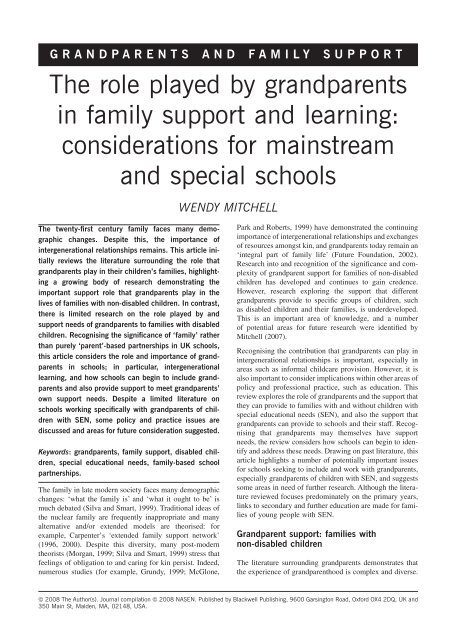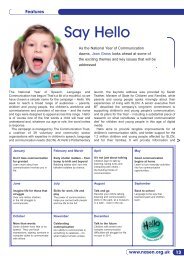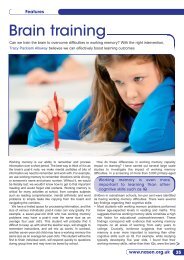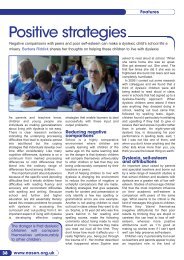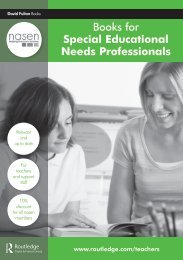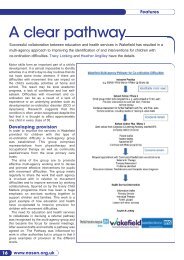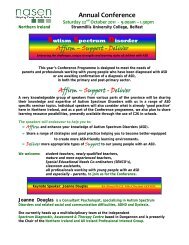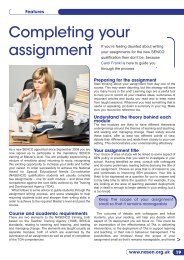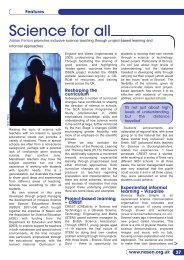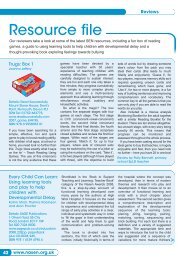The role played by grandparents in family support and ... - Nasen
The role played by grandparents in family support and ... - Nasen
The role played by grandparents in family support and ... - Nasen
You also want an ePaper? Increase the reach of your titles
YUMPU automatically turns print PDFs into web optimized ePapers that Google loves.
with children at home, have been tentatively developed <strong>by</strong>the Basic Skills Agency. Accessibility is also noted asimportant: for example, writ<strong>in</strong>g <strong>in</strong> pla<strong>in</strong> English: ‘I foundthe jargon-buster useful <strong>and</strong> have passed it on to other sets of<strong>gr<strong>and</strong>parents</strong>’ (Gyllenspetz, 2007, p. 23).As a ‘community resource’ <strong>in</strong> l<strong>in</strong>e with the current Englishpolicy of extended schools (DfES, 2004a, b), schools canplay an important <strong>role</strong> provid<strong>in</strong>g <strong>support</strong> for <strong>gr<strong>and</strong>parents</strong>,‘signpost<strong>in</strong>g’ them to alternative social <strong>and</strong> health care communityresources. Collaborative <strong>and</strong> co-ord<strong>in</strong>ated <strong>in</strong>teragencywork<strong>in</strong>g is thus important for schools <strong>and</strong> their staff.However, not all <strong>gr<strong>and</strong>parents</strong> want or need the same degreeof <strong>support</strong>. Watson <strong>and</strong> Kobl<strong>in</strong>sky’s (2000) study foundclass differentials, with work<strong>in</strong>g-class gr<strong>and</strong>mothers morelikely to express a need <strong>and</strong>/or desire for more <strong>support</strong> thanmiddle-class gr<strong>and</strong>mothers. Furthermore, one cannotpresume that schools <strong>and</strong> their staff will <strong>in</strong>clude all types of<strong>gr<strong>and</strong>parents</strong> equitably or even want to beg<strong>in</strong> to movetowards a broader ‘<strong>family</strong> focus’.Although relatively small scale, F<strong>in</strong>dler’s (2007) study ofma<strong>in</strong>stream <strong>and</strong> SEN teachers <strong>in</strong> Israel (80 ma<strong>in</strong>stream <strong>and</strong>82 SEN) found a complex <strong>and</strong> somewhat contradictorysituation, with teachers (both ma<strong>in</strong>stream <strong>and</strong> SEN)recognis<strong>in</strong>g the <strong>support</strong>ive <strong>role</strong> that <strong>gr<strong>and</strong>parents</strong> generallyplay <strong>in</strong> <strong>family</strong> life, but, <strong>in</strong> practice, <strong>in</strong>volv<strong>in</strong>g some morethan others – <strong>in</strong> particular, maternal rather than paternal<strong>gr<strong>and</strong>parents</strong>. F<strong>in</strong>dler suggests this reflects the teachers’wider commonsense knowledge of who provided the most<strong>support</strong> <strong>and</strong> its perceived value. F<strong>in</strong>dler also found that theeveryday knowledge of both ma<strong>in</strong>stream <strong>and</strong> SEN teacherswas not used to <strong>in</strong>form or guide their practice whenwork<strong>in</strong>g with families, as <strong>gr<strong>and</strong>parents</strong> were <strong>in</strong>frequently<strong>in</strong>volved. Furthermore, the teachers she <strong>in</strong>terviewed werenot <strong>in</strong>terested <strong>in</strong> or will<strong>in</strong>g to change or even extend theirfuture practice; there was little enthusiasm for work<strong>in</strong>g with<strong>gr<strong>and</strong>parents</strong>.Schools <strong>and</strong> <strong>gr<strong>and</strong>parents</strong> with children whohave SENVery few specific studies were identified explor<strong>in</strong>g schoolswork<strong>in</strong>g with or consider<strong>in</strong>g, the <strong>support</strong> that <strong>gr<strong>and</strong>parents</strong>provide to families of children with SEN. One notableexception is the development of a model of ‘extended <strong>family</strong>tra<strong>in</strong><strong>in</strong>g’ at Sunfield, an <strong>in</strong>dependent, UK-based specialschool (Carpenter, Addenbrooke, Attfield <strong>and</strong> Conway,2004). <strong>The</strong> school worked with a range of <strong>family</strong> members,<strong>in</strong>clud<strong>in</strong>g <strong>gr<strong>and</strong>parents</strong>, recognis<strong>in</strong>g the importance of professionals<strong>and</strong> different members of families shar<strong>in</strong>g ideas.Indeed, <strong>family</strong> members frequently adopted the <strong>role</strong> of‘tra<strong>in</strong>ers’, an experience viewed as positive <strong>by</strong> all parties –families <strong>and</strong> professionals alike. Although progressive, thiswork rema<strong>in</strong>s small scale <strong>and</strong> specific. <strong>The</strong> general dearth ofstudies, especially larger scale studies, is an important gap<strong>in</strong> the literature as children with SEN have many differenttypes of <strong>support</strong> needs <strong>and</strong> disabilities, <strong>and</strong> there are a substantialnumber of pupils with SEN: currently 229,100pupils (2.8 per cent) across all English schools have Statementsof SEN <strong>and</strong> a larger number (1,333,400 pupils or 16.4per cent) have SEN but do not have Statements (DfES,2007b). Despite this, the literature surround<strong>in</strong>g ma<strong>in</strong>streamschools <strong>and</strong> <strong>gr<strong>and</strong>parents</strong> <strong>and</strong> the <strong>support</strong> <strong>gr<strong>and</strong>parents</strong> canprovide to disabled children (summarised above) does raisea number of issues.Past studies explor<strong>in</strong>g the benefits of <strong>in</strong>tergenerationallearn<strong>in</strong>g <strong>and</strong> <strong>gr<strong>and</strong>parents</strong> as volunteers have tended tofocus on early <strong>and</strong> primary years education (Al-Azami,2006; Gyllenspetz, 2007; Kenner, Arju, Gregory, Jessel <strong>and</strong>Ru<strong>by</strong>, 2004; Kenner, Ru<strong>by</strong>, Jessel, Gregory <strong>and</strong> Arju, 2007).However, the educational <strong>and</strong> <strong>support</strong> <strong>role</strong> of <strong>gr<strong>and</strong>parents</strong>may have an extended relevance <strong>and</strong> value for children withSEN, especially those with learn<strong>in</strong>g disabilities. Develop<strong>in</strong>gcore language, l<strong>in</strong>guistic <strong>and</strong> numeracy skills rema<strong>in</strong>simportant for many children <strong>and</strong> young people with learn<strong>in</strong>gdisabilities <strong>in</strong> both secondary <strong>and</strong> further education. Many‘life skills’ <strong>and</strong> ‘preparation for <strong>in</strong>dependence’ courses<strong>in</strong>clude cook<strong>in</strong>g, garden<strong>in</strong>g <strong>and</strong> shopp<strong>in</strong>g modules, which,as noted earlier, are key <strong>in</strong>tergenerational learn<strong>in</strong>g activities.For young people with SEN, this type of learn<strong>in</strong>g could bean important resource for schools <strong>and</strong> colleges to utilise. Inaddition, Kenner <strong>and</strong> colleagues’ (2007) work demonstratesthe value of reciprocal learn<strong>in</strong>g for both <strong>gr<strong>and</strong>parents</strong> <strong>and</strong>gr<strong>and</strong>children. For children <strong>and</strong> young people with SEN,show<strong>in</strong>g <strong>gr<strong>and</strong>parents</strong> ‘how to do th<strong>in</strong>gs’, such as demonstrat<strong>in</strong>gIT skills, may provide an opportunity for schools tofacilitate positive learn<strong>in</strong>g experiences. With the currenteducational focus on educational outcomes, such as SATS<strong>and</strong> exam results, opportunities for young people with SENto achieve are not always apparent.<strong>The</strong> value of provid<strong>in</strong>g accessible school-based <strong>in</strong>formationfor <strong>gr<strong>and</strong>parents</strong> (Gyllenspetz, 2007) <strong>and</strong> also disabilityspecific<strong>in</strong>formation to <strong>gr<strong>and</strong>parents</strong> of disabled children(Burns <strong>and</strong> Madian, 1992; F<strong>in</strong>dler, 2007; Schilmoeller <strong>and</strong>Baranowski, 1998) was noted above. Schools have thepotential, especially <strong>in</strong> their ‘extended’ status, to be a usefulresource <strong>and</strong> <strong>in</strong>formation provider for families of childrenwith SEN <strong>in</strong> terms of <strong>in</strong>formation for <strong>gr<strong>and</strong>parents</strong> abouttheir gr<strong>and</strong>child’s school <strong>and</strong> also disability-specific <strong>in</strong>formation.Current English guidance (DfES, 2006) advocatesthe value of ‘parent <strong>support</strong> advisers’; this could beextended to <strong>gr<strong>and</strong>parents</strong> of children with SEN. In addition,schools, especially special schools, have frequently been animportant resource for parents of children with SEN toaccess other professionals <strong>and</strong> services, especially health<strong>and</strong> social care. Extend<strong>in</strong>g this provision to <strong>gr<strong>and</strong>parents</strong>,recognis<strong>in</strong>g that <strong>gr<strong>and</strong>parents</strong> of children with SEN maylike to be <strong>in</strong>volved <strong>in</strong> discussions/programmes abouttheir gr<strong>and</strong>child, could be advantageous. Parents provid<strong>in</strong>g<strong>in</strong>formation to <strong>gr<strong>and</strong>parents</strong> can, as Schilmoeller <strong>and</strong>Baranowski (1998) <strong>and</strong> Burns <strong>and</strong> Madian (1992) note, beviewed as stressful, <strong>and</strong> schools could help <strong>support</strong> parents© 2008 <strong>The</strong> Author(s). Journal compilation © 2008 NASEN Support for Learn<strong>in</strong>g · Volume 23 · Number 3 · 2008 131
<strong>in</strong> this task. It may also provide an opportunity for <strong>gr<strong>and</strong>parents</strong>to address their own <strong>support</strong> needs.Amongst some schools, especially special schools wherechildren are provided with school transport, distance mayneed to be considered. Regular opportunities to meet <strong>family</strong>members can be an important factor <strong>in</strong> whom schools<strong>in</strong>clude <strong>in</strong> school/home communication. If <strong>family</strong> membersare not regularly seen <strong>by</strong> staff, this may impact on teachers’perceptions of the need for <strong>and</strong> relevance of ‘<strong>family</strong>’ ratherthan parent partnerships. This was demonstrated <strong>in</strong> F<strong>in</strong>dler’s(2007) study of Israeli ma<strong>in</strong>stream <strong>and</strong> SEN teachers.F<strong>in</strong>dler found that ma<strong>in</strong>stream schools <strong>and</strong> teachers weremore likely to <strong>in</strong>volve <strong>gr<strong>and</strong>parents</strong> rout<strong>in</strong>ely <strong>in</strong> school life<strong>and</strong> <strong>in</strong>volve them <strong>in</strong> child-based discussions than teachers <strong>in</strong>special schools. F<strong>in</strong>dler suggests that a lack of regularcontact of special school teachers with extended <strong>family</strong>members may be an important consideration <strong>in</strong> teachers’perceptions of who is important to <strong>in</strong>clude. This has implicationsfor develop<strong>in</strong>g school/<strong>family</strong> l<strong>in</strong>ks <strong>and</strong> school staff’sknowledge of significant others <strong>in</strong> pupils’ lives: forexample, the <strong>role</strong> <strong>and</strong>/or importance of <strong>gr<strong>and</strong>parents</strong>.Although an <strong>in</strong>creas<strong>in</strong>g number of children with SEN areattend<strong>in</strong>g ma<strong>in</strong>stream schools <strong>in</strong> the UK, school transport isstill frequently provided for children with SEN, <strong>and</strong> teachers’everyday contact with <strong>family</strong> members (such as<strong>gr<strong>and</strong>parents</strong>) rema<strong>in</strong>s an important consideration. Teachersmay have less opportunity to meet these <strong>family</strong> members<strong>and</strong> keep ‘up-to-date’ with any changes <strong>in</strong> <strong>family</strong> circumstances,such as the chang<strong>in</strong>g <strong>role</strong> or importance of<strong>gr<strong>and</strong>parents</strong> <strong>in</strong> pupils’ lives. Residential schools also raisean additional issue as teachers not only have limited everydaycontact with <strong>family</strong> members, but different <strong>family</strong>members are also frequently geographically distanced.Discussion <strong>and</strong> future researchThis review demonstrates that <strong>in</strong>tergenerational relationships<strong>and</strong> exchanges of <strong>support</strong> cont<strong>in</strong>ue to be important <strong>in</strong>late modern society. Research <strong>in</strong>to <strong>and</strong> recognition of thesignificance <strong>and</strong> complexity of gr<strong>and</strong>parent <strong>support</strong> forfamilies of non-disabled children has developed <strong>and</strong> cont<strong>in</strong>uesto ga<strong>in</strong> credence. Despite this, research explor<strong>in</strong>g the<strong>support</strong> that different types of <strong>gr<strong>and</strong>parents</strong> provide to specificfamilies, such as families with disabled children,rema<strong>in</strong>s under-researched. Build<strong>in</strong>g on the knowledge of thecont<strong>in</strong>u<strong>in</strong>g importance but chang<strong>in</strong>g face of <strong>in</strong>tergenerationalrelationships <strong>in</strong> the twenty-first century, it isimportant <strong>and</strong> timely to explore the nature <strong>and</strong> <strong>role</strong> ofgr<strong>and</strong>parent <strong>support</strong> <strong>in</strong> specific areas of <strong>family</strong> life <strong>and</strong>professional practice, such as education. This review hasbegun to explore the <strong>role</strong> <strong>and</strong> importance of <strong>in</strong>tergenerational<strong>support</strong> with<strong>in</strong> schools, both ma<strong>in</strong>stream <strong>and</strong> special.<strong>The</strong> <strong>role</strong> of <strong>gr<strong>and</strong>parents</strong> <strong>and</strong> the <strong>support</strong> they can provide tofamilies with <strong>and</strong> without children with SEN has beenconsidered. <strong>The</strong> review has demonstrated the current significanceof schools (both ma<strong>in</strong>stream <strong>and</strong> special) <strong>in</strong>recognis<strong>in</strong>g the important learn<strong>in</strong>g <strong>and</strong> <strong>support</strong> <strong>role</strong> that<strong>gr<strong>and</strong>parents</strong> can play <strong>in</strong> the lives of their gr<strong>and</strong>children <strong>and</strong>wider <strong>family</strong> networks; <strong>and</strong> also the important <strong>role</strong> thatschools themselves can play <strong>in</strong> provid<strong>in</strong>g <strong>support</strong> <strong>and</strong>/orguidance <strong>in</strong> order to help <strong>gr<strong>and</strong>parents</strong> address their own<strong>support</strong> needs. <strong>The</strong> article demonstrates that work<strong>in</strong>g with<strong>gr<strong>and</strong>parents</strong> has the potential to facilitate positive benefitsfor all parties: schools <strong>and</strong> their staff, <strong>gr<strong>and</strong>parents</strong>, gr<strong>and</strong>children<strong>and</strong> parents.A range of <strong>in</strong>ternational research evidence has been considered,but, despite this, the research evidence base is limited.Many studies are pilot projects <strong>and</strong> quite specific, work<strong>in</strong>gwith small groups of <strong>gr<strong>and</strong>parents</strong> provid<strong>in</strong>g a range of<strong>support</strong> from non-custodial to custodial care. In addition,there is very little specific research focus<strong>in</strong>g on schoolswork<strong>in</strong>g with <strong>gr<strong>and</strong>parents</strong> of children with SEN. Recognis<strong>in</strong>g<strong>gr<strong>and</strong>parents</strong>’ heterogeneity <strong>in</strong> terms of the care theyprovide, their own <strong>support</strong> needs <strong>and</strong> diverse socioeconomiccircumstances, the context of wider <strong>family</strong>relationships <strong>and</strong> the heterogeneity of children with SEN,generalisations must be treated with caution. However, anumber of general issues come to the fore <strong>and</strong> could beconsidered <strong>by</strong> schools <strong>and</strong> their staff. In addition, the reviewhas also sought to identify some specific issues for schoolswork<strong>in</strong>g with families of children with SEN. <strong>The</strong>se aresummarized below:Family partnershipsRecognis<strong>in</strong>g chang<strong>in</strong>g demographic patterns <strong>and</strong> the cont<strong>in</strong>u<strong>in</strong>gsignificance of <strong>in</strong>tergenerational relationships <strong>and</strong><strong>support</strong> networks <strong>in</strong> the twenty-first century, it is timely forschools to th<strong>in</strong>k beyond parent partnerships. Current policyguidance <strong>in</strong> Engl<strong>and</strong> (DfES, 2004a, b; DfES, 2006; DCSF,2007) recognises the importance of schools work<strong>in</strong>g withparents <strong>and</strong> carers; this is a start<strong>in</strong>g po<strong>in</strong>t for provid<strong>in</strong>gpolicy <strong>in</strong>itiatives <strong>and</strong> suggestions for schools <strong>and</strong> their staff.Extend<strong>in</strong>g this focus to a more holistic ‘<strong>family</strong>-based’approach, <strong>in</strong>clud<strong>in</strong>g <strong>gr<strong>and</strong>parents</strong>, would be advantageous,with schools work<strong>in</strong>g to create school/home l<strong>in</strong>ks with familiesas a whole <strong>and</strong> also specific l<strong>in</strong>ks with <strong>gr<strong>and</strong>parents</strong>,where appropriate.Extend<strong>in</strong>g the evidence baseGr<strong>and</strong>parents are a heterogeneous group, provid<strong>in</strong>g differenttypes <strong>and</strong> levels of care <strong>and</strong> with different personal<strong>support</strong> needs. <strong>The</strong> <strong>support</strong> that <strong>gr<strong>and</strong>parents</strong> provide tofamilies with disabled children <strong>and</strong> <strong>gr<strong>and</strong>parents</strong>’ own<strong>support</strong> needs may differ from families of non-disabled children.A similar situation exists with <strong>gr<strong>and</strong>parents</strong> <strong>and</strong>families of children with SEN: as noted above, children withSEN are heterogeneous <strong>and</strong> a broader group than disabledchildren. Recognis<strong>in</strong>g this <strong>and</strong> the absence of specificresearch on gr<strong>and</strong>parent <strong>support</strong> <strong>and</strong> families of childrenwith SEN, more focused research is needed; <strong>in</strong> particular, toexplore the <strong>role</strong> <strong>played</strong> <strong>by</strong> different types of <strong>gr<strong>and</strong>parents</strong>with<strong>in</strong> families of different groups of children with SEN,132 Support for Learn<strong>in</strong>g · Volume 23 · Number 3 · 2008 © 2008 <strong>The</strong> Author(s). Journal compilation © 2008 NASEN
<strong>and</strong> how different types of schools, both ma<strong>in</strong>stream <strong>and</strong>special <strong>in</strong> different sectors (primary, secondary <strong>and</strong> tertiary)can work with <strong>and</strong> <strong>support</strong> <strong>gr<strong>and</strong>parents</strong>.Develop<strong>in</strong>g ‘active’ school policiesRecognis<strong>in</strong>g this potential heterogeneity <strong>and</strong> the fact that<strong>in</strong>clud<strong>in</strong>g <strong>gr<strong>and</strong>parents</strong> <strong>in</strong> school life does not ‘just happen’,active school policies <strong>and</strong> <strong>in</strong>itiatives need to be developed<strong>and</strong> implemented. Some key considerations for schools <strong>and</strong>their staff are the need to be sensitive <strong>and</strong> responsive to<strong>family</strong> diversity, <strong>in</strong>clud<strong>in</strong>g: different social, cultural/ethnic<strong>and</strong> class circumstances <strong>and</strong> <strong>family</strong> relationships (especiallywhich families it is appropriate to work with <strong>in</strong> terms of<strong>gr<strong>and</strong>parents</strong> provid<strong>in</strong>g <strong>support</strong>); the impact of differentschool sett<strong>in</strong>gs; <strong>and</strong> also, the need to th<strong>in</strong>k creatively <strong>in</strong>order to <strong>in</strong>clude geographically distanced <strong>gr<strong>and</strong>parents</strong>.Tra<strong>in</strong><strong>in</strong>g <strong>and</strong> developmentFor schools to value ‘<strong>family</strong>-based’ partnerships, schoolstaff must recognise the contribution <strong>gr<strong>and</strong>parents</strong> can maketo both <strong>family</strong> stability <strong>and</strong> school life. Provid<strong>in</strong>g <strong>in</strong>formation<strong>and</strong> tra<strong>in</strong><strong>in</strong>g for school staff is thus important: ideally,a planned <strong>and</strong> coherent programme implemented withgovernment <strong>and</strong>/or local authority <strong>support</strong>. Facilitat<strong>in</strong>gopportunities for schools to share experiences <strong>and</strong> ‘good’practice would also be beneficial. Acknowledg<strong>in</strong>g thecurrent policy <strong>in</strong> Engl<strong>and</strong> of mov<strong>in</strong>g towards ‘extendedschools’, it is also important for schools <strong>and</strong> their staff towork with other relevant agencies, especially social care <strong>and</strong>health services, shar<strong>in</strong>g ideas <strong>and</strong> knowledge as to how bestto provide <strong>support</strong> to <strong>gr<strong>and</strong>parents</strong>.Listen<strong>in</strong>g to <strong>gr<strong>and</strong>parents</strong>In order to facilitate all of the above, it is important forschools <strong>and</strong> their staff to consult with <strong>and</strong> listen to <strong>gr<strong>and</strong>parents</strong>.Current policy guidance highlights the benefits ofwork<strong>in</strong>g <strong>in</strong> partnership with parents (DCSF, 2007; DfES,2006), this approach could usefully be extended to work<strong>in</strong>gwith <strong>gr<strong>and</strong>parents</strong> – how do <strong>gr<strong>and</strong>parents</strong> want to be<strong>in</strong>cluded, especially <strong>gr<strong>and</strong>parents</strong> of children with SEN;<strong>and</strong>, if they do have specific <strong>support</strong> needs, how can schoolsbeg<strong>in</strong> to address these?ReferencesAL-AZAMI, S. (2006) <strong>The</strong> Silver L<strong>in</strong><strong>in</strong>g of My Life: Learn<strong>in</strong>g with Gr<strong>and</strong>parents.A Report of the Work of the National Development Project2005–2006. Nott<strong>in</strong>gham: Basic Skills Agency.ARTHUR, S., SNAPE, D. <strong>and</strong> DENCH, G. (2003) <strong>The</strong> Moral Economy ofGr<strong>and</strong>parent<strong>in</strong>g. London: National Centre for Social Research.BALES, D. (2003) Gr<strong>and</strong>parents Rais<strong>in</strong>g Gr<strong>and</strong>children: Help<strong>in</strong>g YourGr<strong>and</strong>child Deal with the Death of a Parent (Extension publicationCHFD-E 59-4). Athens, GA: <strong>The</strong> University of Georgia CooperativeExtension Service. [Onl<strong>in</strong>e at www.fcs.uga.edu]BARANOWSKI, M. <strong>and</strong> SCHILMOELLER, G. (1999) Gr<strong>and</strong>parents <strong>in</strong>the lives of gr<strong>and</strong>children with disabilities: mothers’ perceptions. Education<strong>and</strong> Treatment of Children, 22, 4, 427–446.BASHFORD, S. (2004) A parent aga<strong>in</strong>. Children Now, 15–21 September,22–23.BERESFORD, B. (Social Policy Research Unit, University of York) (1994)Positively Parents: Car<strong>in</strong>g for a Severely Disabled Child. London:HMSO.BOSTRÖM, A. K. (2002) Increas<strong>in</strong>g social capital <strong>in</strong> the classroom: achallenge for <strong>in</strong>tergenerational learn<strong>in</strong>g. Education <strong>and</strong> Society, 20,3,91–101.BURNS, C. <strong>and</strong> MADIAN, N. (1992) Experiences with a <strong>support</strong> group for<strong>gr<strong>and</strong>parents</strong> of children with disabilities. Paediatric Nurs<strong>in</strong>g, 18, 1,17–21.CARPENTER, B. (1996) Enabl<strong>in</strong>g partnerships: families <strong>and</strong> schools. InB. Carpenter, R. Ashdown <strong>and</strong> K. Bovair (eds.) Enabl<strong>in</strong>g Access:Effective Teach<strong>in</strong>g <strong>and</strong> Learn<strong>in</strong>g for Pupils with Learn<strong>in</strong>g Difficulties.London: David Fulton.CARPENTER, B. (2000) Susta<strong>in</strong><strong>in</strong>g the <strong>family</strong>: meet<strong>in</strong>g the needs offamilies with disabilities. British Journal of Special Education, 27, 3,135–144.CARPENTER, B., ADDENBROOKE, M., ATTFIELD, E. <strong>and</strong> CONWAY,S. (2004) ‘Celebrat<strong>in</strong>g families’: an <strong>in</strong>clusive model of <strong>family</strong>-centredtra<strong>in</strong><strong>in</strong>g. British Journal of Special Education, 31, 2, 75–80.CLARKE, L. <strong>and</strong> CAIRNS, H. (2001) Gr<strong>and</strong>parents <strong>and</strong> the care of children:the research evidence. In B. Broad (ed.) K<strong>in</strong>ship Care: <strong>The</strong>Placement Choice for Children <strong>and</strong> Young People (pp. 11–20). Dorset:Russell House Publish<strong>in</strong>g.CLARKE, L. <strong>and</strong> ROBERTS, C. (2003) Gr<strong>and</strong>parenthood: Its Mean<strong>in</strong>g<strong>and</strong> Its Contribution to Older People’s Lives (Economic <strong>and</strong> SocialResearch Council (ESRC) Research F<strong>in</strong>d<strong>in</strong>gs 22 from the Grow<strong>in</strong>gOlder Programme). Sheffield: ESRC Grow<strong>in</strong>g Older Programme,Department of Sociological Studies, University of Sheffield. [Onl<strong>in</strong>e at:http://www.grow<strong>in</strong>golder.group.shef.ac.uk/GOF<strong>in</strong>d<strong>in</strong>gs22.pdf]CONTACT A FAMILY (2005) Factsheet for Gr<strong>and</strong>parents. London:Contact-a-Family. [Onl<strong>in</strong>e at http://www.ca<strong>family</strong>.org.uk/<strong>gr<strong>and</strong>parents</strong>.html].DANNISON, L. <strong>and</strong> SMITH, A. (2003) Custodial <strong>gr<strong>and</strong>parents</strong> community<strong>support</strong> program: lessons learned. Children <strong>and</strong> Schools, 25,2,87–95.DAYCARE TRUST (2007) Listen<strong>in</strong>g to Parents of Disabled Childrenabout Childcare. London: Daycare Trust.DCSF (DEPARTMENT FOR CHILDREN, SCHOOLS AND FAMILIES)(2007) <strong>The</strong> Children’s Plan: Build<strong>in</strong>g Brighter Futures. London: <strong>The</strong>Stationery Office. [Onl<strong>in</strong>e at http://www.dfes.gov.uk/publications/childrensplan/]DEAN, H. <strong>and</strong> SHAH, A. (2002) Insecure families <strong>and</strong> low-pay<strong>in</strong>g labourmarkets: comments on the British experience. Journal of Social Policy,31, 1, 61–80.DENCH, G. <strong>and</strong> OGG, J. (2002) Gr<strong>and</strong>parent<strong>in</strong>g <strong>in</strong> Brita<strong>in</strong>: A Basel<strong>in</strong>eStudy. London: Institute of Community Studies.DENCH, G., OGG, J. <strong>and</strong> THOMSON, K. (1999) <strong>The</strong> <strong>role</strong> of <strong>gr<strong>and</strong>parents</strong>.In R. Jowell, J. Curtis, A. Park <strong>and</strong> K. Thomson (eds.) British SocialAttitudes: <strong>The</strong> 16 th Report. Hampshire: Ashgate Publish<strong>in</strong>g.DfES (DEPARTMENT FOR EDUCATION AND SKILLS) (2001) SpecialEducational Needs Code of Practice. London: <strong>The</strong> Stationery Office.DfES (DEPARTMENT FOR EDUCATION AND SKILLS) (2004a)Every Child Matters: Change for Children. London: <strong>The</strong> StationeryOffice.DfES (DEPARTMENT FOR EDUCATION AND SKILLS) (2004b) EveryChild Matters: Change for Children <strong>in</strong> Schools. London: <strong>The</strong> StationeryOffice.DfES (DEPARTMENT FOR EDUCATION AND SKILLS) (2006) ChildcareAct 2006: Chapter 21. Norwich: <strong>The</strong> Stationery Office. [Onl<strong>in</strong>e athttp://www.opsi.gov.uk/acts/acts2006/pdf/ukpga_20060021_en.pdf].DfES (DEPARTMENT FOR EDUCATION AND SKILLS) (2007a) EveryParent Matters: Help<strong>in</strong>g You Help Your Child. London: <strong>The</strong> StationeryOffice.© 2008 <strong>The</strong> Author(s). Journal compilation © 2008 NASEN Support for Learn<strong>in</strong>g · Volume 23 · Number 3 · 2008 133
DfES (DEPARTMENT FOR EDUCATION AND SKILLS) (2007b)Special Educational Needs <strong>in</strong> Engl<strong>and</strong>, January 2007. London: DfES.[Onl<strong>in</strong>e at http://www.dfes.gov.uk/rsgateway/DB/SFR/s000732/sfr20-2007.pdf]DE TOLEDO, S. <strong>and</strong> ELDER BROWN, D. (1995) Gr<strong>and</strong>parents asParents: A Survival Guide for Rais<strong>in</strong>g a Second Family. New York,NY: <strong>The</strong> Guilford Press. Adapted for the ‘Gr<strong>and</strong>parents Rais<strong>in</strong>g Gr<strong>and</strong>kids’program, Texas A&M University. [Onl<strong>in</strong>e at http://fcs.tamu.edu/families/ag<strong>in</strong>g/grg/]DILWORTH-ANDERSON, P. (1994) <strong>The</strong> importance of <strong>gr<strong>and</strong>parents</strong> <strong>in</strong>extended-k<strong>in</strong> caregiv<strong>in</strong>g to black children with sickle cell disease.Journal of Health Social Policy, 5, 3/4, 185–202.DISABILITY DISCRIMINATION ACT (1995) Chapter 50. London: HerMajesty’s Stationery Office. [Onl<strong>in</strong>e at http://www.opsi.gov.uk/ACTS/acts1995/ukpga_19950050_en_1]DTI (DEPARTMENT OF TRADE AND INDUSTRY) (2000) Work <strong>and</strong>Parents: Competitiveness <strong>and</strong> Choice – A Research Review. London:<strong>The</strong> Stationery Office.DUNST, C. J., TRIVETTE, C. M. <strong>and</strong> DEAL, A. G. (1994) Support<strong>in</strong>g <strong>and</strong>Strengthen<strong>in</strong>g Families (Vol. 1): Methods, Strategies <strong>and</strong> Practices.Cambridge, MA: Brookl<strong>in</strong>e Books.EDWARDS, O. W. <strong>and</strong> SWEENEY, A. E. (2007) <strong>The</strong>ory-based <strong>in</strong>terventionsfor school children cared for <strong>by</strong> their <strong>gr<strong>and</strong>parents</strong>. EducationalPsychology <strong>in</strong> Practice, 23, 2, 177–190.EVASON, E., LLOYD, K. <strong>and</strong> DOWDS, L. (2005) Gr<strong>and</strong>parenthood <strong>in</strong>Modern Irel<strong>and</strong>. Dubl<strong>in</strong>: Department of Social <strong>and</strong> Family Affairs(Republic of Irel<strong>and</strong>). [Onl<strong>in</strong>e at: http://www.welfare.ie/publications/granparent.pdf]EVERY DISABLED CHILD MATTERS (2007) Disabled children <strong>and</strong>child poverty (brief<strong>in</strong>g paper). London: Every Disabled Child Matters.FAMILY FUND TRUST (2003) Statistical Analysis. York: Family Fund.FERGUSON, N. (2004) Gr<strong>and</strong>parent<strong>in</strong>g <strong>in</strong> Divorced Families. Bristol:Policy Press.FINDLER, L. (2000) <strong>The</strong> <strong>role</strong> of <strong>gr<strong>and</strong>parents</strong> <strong>in</strong> the social <strong>support</strong> systemof mothers of children with a physical disability. Families <strong>in</strong> Society:Journal of Contemporary Human Services, 81, 4, 370–381.FINDLER, L. (2007) Gr<strong>and</strong>parents – the overlooked potential partners:perceptions <strong>and</strong> practice of teachers <strong>in</strong> special <strong>and</strong> regular education.European Journal of Special Needs Education, 22, 2, 199–216.FINDLER, L. <strong>and</strong> BEN-ARI, O. (2003) Social workers’ perceptions <strong>and</strong>practice regard<strong>in</strong>g <strong>gr<strong>and</strong>parents</strong> <strong>in</strong> families of children with a developmentaldisability. Families <strong>in</strong> Society, 84, 1, 86–99.FUTURE FOUNDATION (2002) Complicated Lives III: a report <strong>by</strong>the Future Foundation for Abbey National. London: FutureFoundation.GARDNER, J., SCHERMAN, A., MOBLEY, D., BROWN, P. <strong>and</strong>SCHUTTER, M. (1994) Gr<strong>and</strong>parents’ beliefs regard<strong>in</strong>g their <strong>role</strong> <strong>and</strong>relationship with special needs gr<strong>and</strong>children. Education <strong>and</strong> Treatmentof Children, 17, 2, 185–196.GEORGE, J. (1988) <strong>The</strong>rapeutic <strong>in</strong>tervention for <strong>gr<strong>and</strong>parents</strong> <strong>and</strong>extended families of children with developmental delays. Mental Retardation,26, 369–375.GRANDPARENTS PLUS (2003) Gr<strong>and</strong>parents Talk<strong>in</strong>g: Report ofSem<strong>in</strong>ar Held at the Nuffield Foundation, London (5 June). London:Gr<strong>and</strong>parents Plus.GRANT, R., GORDON, S. G. <strong>and</strong> COHEN, S. T. (1997) An <strong>in</strong>novativeschool-based <strong>in</strong>tergenerational model to serve gr<strong>and</strong>parent caregivers.Journal of Gerontological Social Work, 28, 1/2, 47–61.GRAY, A. (2005a) <strong>The</strong> chang<strong>in</strong>g availability of <strong>gr<strong>and</strong>parents</strong> as carers <strong>and</strong>its implications for childcare policy <strong>in</strong> the UK. Journal of Social Policy,34, 4, 557–577.GRAY, A. with GRANDPARENTS ASSOCIATION (2005b) An Evaluationof the Gr<strong>and</strong>parent–Toddler Groups Initiative. London: Families<strong>and</strong> Social Capital Group, South Bank University.GREEN, S. (2001) Gr<strong>and</strong>ma’s h<strong>and</strong>s: parental perceptions of the importanceof <strong>gr<strong>and</strong>parents</strong> as secondary caregivers <strong>in</strong> families of childrenwith disabilities. International Journal of Age<strong>in</strong>g <strong>and</strong> Human Development,53, 1, 11–33.GREGORY, E., ARJU, T., JESSEL, J., KENNER, C. <strong>and</strong> RUBY, M.(2007) Snow white <strong>in</strong> different guises: <strong>in</strong>terl<strong>in</strong>gual <strong>and</strong> <strong>in</strong>terculturalexchanges between <strong>gr<strong>and</strong>parents</strong> <strong>and</strong> young children at home <strong>in</strong> EastLondon. Journal of Early Childhood Literacy, 7, 1, 5–25.GRUNDY, E. (1999) Look<strong>in</strong>g beyond the household: <strong>in</strong>tergenerationalperspectives on liv<strong>in</strong>g k<strong>in</strong> <strong>and</strong> contacts with k<strong>in</strong> <strong>in</strong> Great Brita<strong>in</strong>. PopulationTrends, 97, 19–27.GYLLENSPETZ, I. (2007) Learn<strong>in</strong>g with Gr<strong>and</strong>parents: Triall<strong>in</strong>g theMaterials. Leicester: Basic Skills Agency @ NIACE.HARRIS, S., HANDLEMAN, J. <strong>and</strong> PALMER, C. (1985) Parents <strong>and</strong><strong>gr<strong>and</strong>parents</strong> view the autistic child. Journal of Autism <strong>and</strong> DevelopmentalDisorders, 15, 2, 127–137.HASTINGS, R. (1997) Gr<strong>and</strong>parents of children with disabilities: a review.International Journal of Disability, Development <strong>and</strong> Education, 44, 4,329–340.HASTINGS, R., THOMAS, H. <strong>and</strong> DELWICHE, N. (2002) Gr<strong>and</strong>parents’<strong>support</strong> for children with Down’s Syndrome. Journal of AppliedResearch <strong>in</strong> Intellectual Disabilities, 15, 1, 97–104.HATTON, C., AKRAM, Y., SHAH, R., ROBERTSON, J. <strong>and</strong> EMERSON,E. (2004) Support<strong>in</strong>g South Asian Families with a Child with SevereDisabilities. London: Jessica K<strong>in</strong>gsley.HM TREASURY, DEPARTMENT FOR EDUCATION AND SKILLS(DfES), DEPARTMENT FOR WORK AND PENSIONS (DWP),DEPARTMENT OF TRADE AND INDUSTRY (DTI) (2004) Choicefor Parents, the Best Start for Children: A Ten Year Strategy for Childcare.London: <strong>The</strong> Stationery Office.HORNBY, G. <strong>and</strong> ASHWORTH, T. (1994) Gr<strong>and</strong>parents’ <strong>support</strong> forfamilies who have children with disabilities. Journal of Child FamilyStudies, 3, 403–412.HORTON, T. V. <strong>and</strong> WALLENDER, J. L. (2001) Hope <strong>and</strong> social <strong>support</strong>as resilience factors aga<strong>in</strong>st psychological distress of mothers who carefor children with chronic physical conditions. Rehabilitation Psychology,46, 382–399.JESSEL, J., GREGORY, E., ARJU, T., KENNER, C. <strong>and</strong> RUBY, M.(2004) Children <strong>and</strong> their <strong>gr<strong>and</strong>parents</strong> at home: a mutually <strong>support</strong>ivecontext for learn<strong>in</strong>g <strong>and</strong> l<strong>in</strong>guistic development. English Quarterly,36,4, 16–23.KAGAN, C., LEWIS, S. <strong>and</strong> HEATON, P. (1998) Comb<strong>in</strong><strong>in</strong>g Work <strong>and</strong>Care: Work<strong>in</strong>g Parents of Disabled Children (F<strong>in</strong>d<strong>in</strong>gs: Ref. 538).York: Joseph Rowntree Foundation.KENNER, C., ARJU, T., GREGORY, E., JESSEL, J. <strong>and</strong> RUBY, M.(2004) <strong>The</strong> <strong>role</strong> of <strong>gr<strong>and</strong>parents</strong> <strong>in</strong> children’s learn<strong>in</strong>g. Primary Practice,38, 41–44.KENNER, C., RUBY, M., JESSEL, J., GREGORY, E. <strong>and</strong> ARJU, T.(2007) Intergenerational learn<strong>in</strong>g between children <strong>and</strong> <strong>gr<strong>and</strong>parents</strong> <strong>in</strong>East London. Journal of Early Childhood Research, 5,3,219–243.KNUSSEN, C. <strong>and</strong> SLOPER, P. (1992) Stress <strong>in</strong> families of children witha disability: a review of risk <strong>and</strong> resistance factors. Journal of MentalHealth, 1, 241–256.KROPF, N. <strong>and</strong> BURNETTE, D. (2003) Gr<strong>and</strong>parents as <strong>family</strong> caregivers:lessons for <strong>in</strong>tergenerational education. EducationalGerontology, 29, 4, 361–372.LAVERS, C. <strong>and</strong> SONUGA-BARKER, E. J. S. (1997) Annotation: on thegr<strong>and</strong>mothers’ <strong>role</strong> <strong>in</strong> the adjustment <strong>and</strong> maladjustment of gr<strong>and</strong>children.Journal of Child Psychology <strong>and</strong> Psychiatry, 38, 7, 747–753.LAWRENCE-WEBB, C., OKUNDAYE, J. <strong>and</strong> HAFNER, G. (2003) Education<strong>and</strong> k<strong>in</strong>ship caregivers: creat<strong>in</strong>g a new vision. Families <strong>in</strong>Society: Journal of Contemporary Human Services, 84, 1, 135–142.LUSSIER, G., DEATER-DECKARD, K., DUNN, J. <strong>and</strong> DAVIES, L.(2002) Support across two generations. Journal of Family Psychology,16, 363–376.McGLONE, F., PARK, A. <strong>and</strong> ROBERTS, C. (1999) K<strong>in</strong>ship <strong>and</strong> friendships:attitudes <strong>and</strong> behaviour <strong>in</strong> Brita<strong>in</strong> 1986–1995. In S. McRae (ed.)Chang<strong>in</strong>g Brita<strong>in</strong>: Families <strong>and</strong> Households <strong>in</strong> the 1990s (pp. 141–155). Oxford: Oxford University Press.MIRFIN-VEITCH, B. <strong>and</strong> BRAY, A. (1997) Gr<strong>and</strong>parents: part of the<strong>family</strong>. In B. Carpenter (ed.) Families <strong>in</strong> Context: Emerg<strong>in</strong>g Trends <strong>in</strong>Family Support <strong>and</strong> Early Intervention (pp. 76–88). London: DavidFulton.MIRFIN-VEITCH, B., BRAY, A. <strong>and</strong> WATSON, M. (1996) ‘<strong>The</strong>y really docare’: <strong>gr<strong>and</strong>parents</strong> as <strong>in</strong>formal <strong>support</strong> sources for families of childrenwith disabilities. New Zeal<strong>and</strong> Journal of Disabilities, 2, 136–148.134 Support for Learn<strong>in</strong>g · Volume 23 · Number 3 · 2008 © 2008 <strong>The</strong> Author(s). Journal compilation © 2008 NASEN
MIRFIN-VEITCH, B., BRAY, A. <strong>and</strong> WATSON, M. (1997) ‘We’re justthat sort of <strong>family</strong>’: <strong>in</strong>tergenerational relationships <strong>in</strong> families <strong>in</strong>clud<strong>in</strong>gchildren with disabilities. Family Relations, 46, 2, 305–311.MITCHELL, W. (2007) Research review: the <strong>role</strong> of <strong>gr<strong>and</strong>parents</strong> <strong>in</strong> <strong>in</strong>tergenerational<strong>support</strong> for families with disabled children: a review of theliterature. Child <strong>and</strong> Family Social Work, 12, 94–101.MITCHELL, W. <strong>and</strong> GREEN, E. (2002) ‘I don’t know what I’d do withoutMam’: motherhood, identity <strong>and</strong> <strong>support</strong> networks. SociologicalReview, 50, 1, 1–22.MORGAN, D. (1999) Risk <strong>and</strong> <strong>family</strong> practices: account<strong>in</strong>g for change<strong>and</strong> fluidity <strong>in</strong> <strong>family</strong> life. In B. Silva <strong>and</strong> C. Smart (eds.) <strong>The</strong> NewFamily (pp. 13–30). London: Sage.NYBO, W., SCHERMAN, A. <strong>and</strong> FREEMAN, P. (1998) Gr<strong>and</strong>parents’<strong>role</strong> <strong>in</strong> <strong>family</strong> systems with a deaf child. American Annals of the Deaf,143, 3, 260–267.PRIME MINISTER’S STRATEGY UNIT (2005) Improv<strong>in</strong>g the LifeChances of Disabled People. London: <strong>The</strong> Stationery Office.REYNOLDS, G., WRIGHT, J. <strong>and</strong> BEALE, B. (2003) <strong>The</strong> <strong>role</strong>s of <strong>gr<strong>and</strong>parents</strong><strong>in</strong> educat<strong>in</strong>g today’s children. Journal of InstructionalPsychology, 30, 4, 316–325.RICHARDS, A. (2001) Second Time Around: A Survey of Gr<strong>and</strong>parentsRais<strong>in</strong>g their Gr<strong>and</strong>children. London: Family Rights Group.ROBERTS, K. <strong>and</strong> LAWTON, D. (2001) Acknowledg<strong>in</strong>g the extra careparents give their disabled children. Child: Care, Health <strong>and</strong> Development,27, 4, 307–319.ROSS, N., HILL, M., SWEETING, S. <strong>and</strong> CUNNINGHAM-BURLEY, S.(2006) Gr<strong>and</strong>parents <strong>and</strong> Teen Gr<strong>and</strong>children: Explor<strong>in</strong>g IntergenerationalRelationships. Glasgow: University of Strathclyde [Onl<strong>in</strong>e athttp://www.gccs.gla.ac.uk/docs/pdf/Gr<strong>and</strong>parents_Teen_Children.pdf]RUBY, M., KENNER, C., JESSEL, J., GREGORY, E. <strong>and</strong> ARJU, T.(2007) Garden<strong>in</strong>g with <strong>gr<strong>and</strong>parents</strong>: an early engagement with thescience curriculum. Early Years, 27, 2, 131–144.SANDLER, A., WARREN, S. <strong>and</strong> RAVER, S. (1995) Gr<strong>and</strong>parents as asource of <strong>support</strong> for parents of children with disabilities: a brief report.Mental Retardation, 33, 248–250.SCHILMOELLER, G. <strong>and</strong> BARANOWSKI, M. (1998) Intergenerational<strong>support</strong> <strong>in</strong> families with disabilities: <strong>gr<strong>and</strong>parents</strong>’ perspectives.Families <strong>in</strong> Society, 79, 5, 465–476.SELIGMAN, M. (1991) Gr<strong>and</strong>parents of disabled children: hopes, fears<strong>and</strong> adaptation. Families <strong>in</strong> Society, 72 (March), 147–152.SELIGMAN, M., GOODWIN, G., PASCHAL, K., APPLEGATE, A. <strong>and</strong>LEHMAN, L. (1997) Gr<strong>and</strong>parents of children with disabilities: perceivedlevels of <strong>support</strong>. Education <strong>and</strong> Tra<strong>in</strong><strong>in</strong>g <strong>in</strong> Mental Retardation<strong>and</strong> Developmental Disabilities, 32, 4, 293–303.SILVA, E. <strong>and</strong> SMART, C. (eds.) (1999) <strong>The</strong> New Family? London:Sage.STRANDE, P. O. (2007) Project: School Gr<strong>and</strong>parents (F<strong>in</strong>al Report).Hamar, Norway: Directorate for Primary <strong>and</strong> Secondary Education.STROM, R. D. <strong>and</strong> STROM, S. K. (1995) Intergenerational learn<strong>in</strong>g:<strong>gr<strong>and</strong>parents</strong> <strong>in</strong> the schools. Educational Gerontology, 21, 4, 321–335.TRUTE, B. (2003) Gr<strong>and</strong>parents of children with developmental disabilities:<strong>in</strong>tergenerational <strong>support</strong> <strong>and</strong> well-be<strong>in</strong>g. Families <strong>in</strong> Society:Journal of Contemporary Human Services, 84, 1, 119–126.VADASY, P., FEWELL, R. <strong>and</strong> MEYER, D. (1996) Gr<strong>and</strong>parents ofchildren with special needs: <strong>in</strong>sights <strong>in</strong>to their experiences <strong>and</strong> concerns.Journal of the Division of Early Childhood, 10, 36–44.WATSON, J. A. <strong>and</strong> KOBLINSKY, S. A. (2000) Strengths <strong>and</strong> needs ofAfrican American <strong>and</strong> European American gr<strong>and</strong>mothers <strong>in</strong> thework<strong>in</strong>g <strong>and</strong> middle classes. Journal of Negro Education, 69, 3, 199–214.WHEELOCK, J. <strong>and</strong> JONES, K. (2002) ‘Gr<strong>and</strong>parents are the next bestth<strong>in</strong>g’: <strong>in</strong>formal childcare for work<strong>in</strong>g parents <strong>in</strong> urban Brita<strong>in</strong>. Journalof Social Policy, 31, 441–463.CorrespondenceWendy MitchellSocial Policy Research UnitUniversity of YorkYorkYO10 5DDEmail: wam1@york.ac.uk© 2008 <strong>The</strong> Author(s). Journal compilation © 2008 NASEN Support for Learn<strong>in</strong>g · Volume 23 · Number 3 · 2008 135


